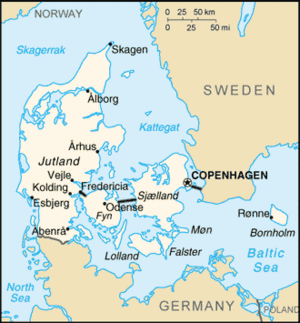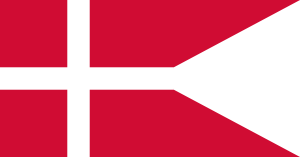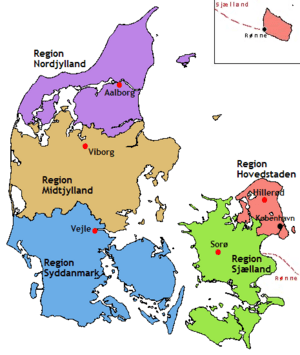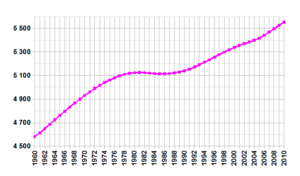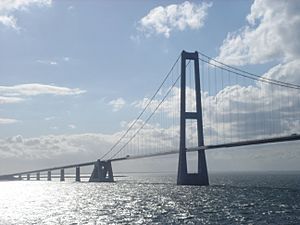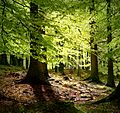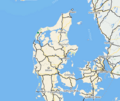Denmark facts for kids
Quick facts for kids
Kingdom of Denmark
Kongeriget Danmark (Danish)
|
|
|---|---|
|
Anthems:
Der er et yndigt land (English: "There is a lovely country") Kong Christian stod ved højen mast (English: "King Christian stood by the lofty mast") |
|
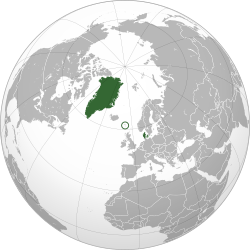
Location of the Kingdom of Denmark (green), including Greenland, the Faroe Islands (circled), and Denmark proper
|
|

Location of Denmark proper (dark green)
– on the European continent (green & dark grey) |
|
| Capital and largest city
|
Copenhagen 55°43′N 12°34′E / 55.717°N 12.567°E |
| Official languages | Danish |
| Recognised regional languages | Faroese Greenlandic German |
| Ethnic groups |
Indigenous status:
Minority status:
Other:
|
| Religion
(2020)
|
75.8% Christianity —74.3% Church of Denmark —1.5% Other Christian 19.1% No religion 4.4% Islam 0.7% Others |
| Demonym(s) | |
| Government | Unitary parliamentary constitutional monarchy |
|
• Monarch
|
Frederik X |
| Mette Frederiksen | |
| Legislature | Folketing |
| History | |
| c. 8th century | |
|
• Constitutional Act
|
5 June 1849 |
| 24 March 1948 | |
|
• EEC accession
|
1 January 1973 |
| Area | |
|
• Denmark proper
|
42,933 km2 (16,577 sq mi) (130th) |
|
• Entire kingdom
|
2,220,930 km2 (857,510 sq mi) (12th) |
| Population | |
|
• Q3 2020 estimate
|
|
|
• Faroe Islands
|
52,110 |
|
• Greenland
|
56,081 |
|
• Density (Denmark)
|
137.65/km2 (356.5/sq mi) |
| GDP (PPP) | 2018 estimate |
|
• Total
|
$299 billion (52nd) |
|
• Per capita
|
$51,643 (19th) |
| GDP (nominal) | 2018 estimate |
|
• Total
|
$370 billion (34th) |
|
• Per capita
|
$63,829 (6th) |
| Gini (2019) | ▼ 27.5 low |
| HDI (2019) | very high · 10th |
| Currency | Danish krone (DKK) |
| Time zone | UTC+1 (CET) |
|
• Summer (DST)
|
UTC+2 (CEST) |
| Driving side | right |
| Calling code |
3 calling codes
+45 (Denmark)
+298 (Faroe Islands) +299 (Greenland) |
| ISO 3166 code | DK |
| Internet TLD | |
|
Website
Denmark.dk |
|
Denmark (Danish: Danmark), officially called the Kingdom of Denmark, is a Nordic country in Northern Europe. It is the most southern country in Scandinavia. Denmark is south of Norway and southwest of Sweden, which it connects to by a bridge. It shares a border with Germany to the south. The country is next to the North Sea in the west and the Baltic Sea in the east.
Denmark is a developed country with a strong welfare state. This means the government provides many services to its people. In 2006 and 2007, surveys even called Denmark "the happiest place in the world." This was based on how good their health, welfare, and education systems are.
The name Denmark (Danish: Danmark) has an interesting, but unclear, origin. In Old Norse, it was called Danmǫrk. This might have meant the "Danish March," referring to the borderlands of the Danes.
Copenhagen, located on the island of Zealand, is the capital city of Denmark. Denmark is a constitutional monarchy. This means it has a king or queen as the head of state, but their power is limited by a constitution. The current monarch is King Frederik X. Denmark also has a parliamentary system, where people elect a parliament to make decisions. The government is a democracy led by an elected Prime Minister, who is currently Mette Frederiksen since 2019.
Contents
History of Denmark
Denmark first became a united country in the 10th century, during the Viking age. King Harald Bluetooth united the country around 985 AD and introduced Christianity to Denmark. Vikings were famous for exploring and sometimes invading other lands. In the 11th century, Danish Vikings even controlled parts of England, known as the Danelaw, for a while.
In 1397, Denmark, Sweden, and Norway joined together under one queen. This union was called the Kalmar Union. Sweden left the union in 1523 to become its own country again. Denmark and Norway, known as Denmark-Norway, stayed united until 1814. This larger kingdom controlled many islands in the Atlantic Ocean, including the Faroe Islands, Iceland, and Greenland. Iceland later became independent from Denmark in 1944.
Denmark became a constitutional monarchy on June 5, 1849. On this day, a new constitution was adopted. This new law reduced the king's power and gave more rights to ordinary Danish people. Because of this important event, June 5 is now a holiday in Denmark, called "Constitution Day."
Over time, Denmark lost control of some of its lands in battles. One of Denmark's biggest defeats was the Second Schleswig War in 1864. In this war, the regions of Schleswig and Holstein were taken by the Kingdom of Prussia, which is now part of Germany. After this big loss, Denmark decided to follow a policy of neutrality. This meant it would try not to get involved in wars or support other countries. Denmark did not take part in the First World War.
However, on April 9, 1940, Nazi Germany invaded Denmark. The Nazis occupied Denmark throughout World War II. During the war, in 1943, Danes bravely helped over 8,000 Jewish people escape from Denmark to Sweden. They did this when the Nazis tried to arrest them.
After World War II, Denmark joined NATO and the European Union. Today, Greenland and the Faroe Islands are part of the Kingdom of Denmark. They have their own governments and some self-rule, but Denmark still holds their overall authority.
Geography of Denmark
Denmark is the smallest of the Scandinavian countries. Its neighbors are Germany to the south, Sweden to the east, Norway to the north, and the United Kingdom to the west. The country is mostly surrounded by the sea. The largest part of Denmark is Jutland (Jylland), which is a peninsula connected to Germany by land.
The rest of Denmark is made up of many islands. There are 76 islands where people live, plus many tiny ones. The biggest islands are Zealand (Sjælland) and Funen (Fyn). To the southeast, in the Baltic Sea, is the island of Bornholm. This is the only place in Denmark where you can see the natural bedrock.
Denmark is a very flat country. The highest point is Møllehøj, which is only about 170.86 meters (560.56 feet) tall. You'll find many small hills, lakes, creeks, forests, and farms. Denmark has a very long coastline, stretching 7,314 km (4,545 miles). No one in Denmark lives more than 60 km (37 miles) from the coast. The longest river in Denmark is the Gudenå.
Danish Climate and Weather
The weather in Denmark is often windy and rainy. In the winter, it doesn't usually get extremely cold. Most years, there are only a few weeks of snow. It's rare for the sea around the islands to freeze over, maybe once every ten years. The climate and flat land are not ideal for winter sports like skiing.
Most summers are not very hot. People usually dress in layers to be ready for rain or wind. There are sunny periods too, but it's hard to predict exactly when they will be. The best time for outdoor activities is usually in May and June, leading up to midsummer.
The highest temperature ever recorded in Denmark was 36.4°C (97.5°F) on August 10, 1975, in Holstebro. The lowest temperature ever recorded was -31.2°C (-24.2°F) on January 8, 1982, in Hørsted.
Government and Politics
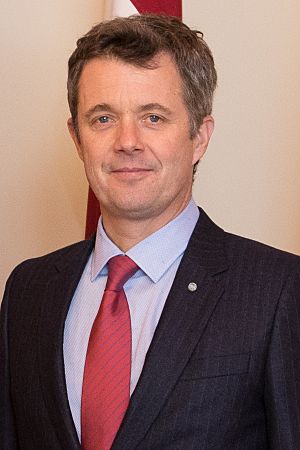
Denmark's government has three main parts, called branches of power. These are the judiciary (the courts), the executive (the Prime Minister and their team), and the legislature (the Danish parliament). The current Prime Minister of Denmark is Mette Frederiksen, who was elected in June 2019.
Denmark is a Kingdom, which means it has a monarch (a king or queen). The current monarch is King Frederik X. He became king on January 14, 2024, after his mother, Margrethe II, decided to step down. The king has a symbolic role and does not make major political decisions. Denmark became a constitutional monarchy in 1849, which set these limits on the monarch's power.
Elections for the parliament happen every four years. The political party or group of parties that wins the most votes and seats forms the government. Often, several parties that agree on things will join together to create a coalition government. The leader of the largest party in this group then becomes the prime minister.
Welfare State in Denmark
Denmark, like other Nordic countries, is known for being a strong welfare state. This means the government provides many important services to its citizens. These services include free health care, free education (from school to college), and help with housing for those who need it. To pay for these services, Danes pay higher taxes.
The Kingdom of Denmark
When we talk about Denmark in geography, we mean the land in northern Europe where the Danes live. But in a political sense, the Kingdom of Denmark is a larger area. It includes Denmark itself, plus the Faroe Islands in the Atlantic Ocean and Greenland in North America.
All three parts of the kingdom have their own unique languages and cultures. The Faroe Islands and Greenland are often seen as separate countries. However, Denmark still holds their overall sovereignty, meaning it has the highest authority over them.
Regions and Municipalities
Denmark is divided into five large areas called regions (in Danish: regioner). These regions took over from the older "counties" in January 2007. The main job of the regions is to manage hospitals and health care services.
The regions are then split into smaller areas called municipalities (Danish: kommuner). Currently, there are 98 municipalities. Before January 2007, there were 275. The number was reduced to make local government more efficient, with each municipality aiming to have at least 20,000 people.
People of Denmark
Most of Denmark's population, which is just under 5.4 million people, are of Danish background. This was about 90.5% in 2009. The remaining 8.9% are immigrants or people whose families recently immigrated. Many of these come from South Asia or the Middle East. There are also smaller groups of Inuit people from Greenland and Faroese people.
Other minority groups in Denmark include people from Turkey, Poland, Syria, Germany, Iraq, Romania, and countries from former Yugoslavia. There are also other groups from Asia and Africa. Small numbers of Roma and Hungarians live in Denmark, as well as a small Jewish population.
The national language spoken by Danes is Danish. This language is very similar to other Scandinavian languages. Most Danes can understand Swedish and Norwegian because they are so close to Danish.
Besides Danish, most Danes also speak another language, like English. English is very popular as an international language. Some people also speak German. In the southern part of Jutland, a German minority speaks German. On the Faroe Islands, people speak Faroese, and in Greenland, people speak Inuit.
Religion doesn't play a big part in the daily lives of most Danes, and not many people go to church regularly. Even though many Danes are atheist, about 80.4% are members of the Protestant "Church of Denmark" (Danish: Folkekirke). This is the official "state church" of Denmark. The National Church is Lutheran, meaning it separated from the Roman Catholic Church in the 16th century. Other important faiths include Judaism, Islam (which is growing), other Protestant groups, and Catholicism.
Transport in Denmark
Because Denmark has so many islands, it also has many bridges. The main parts of the country and most of the larger islands are connected by roads and railroads. One of the world's longest bridges connects the eastern and western parts of Denmark. There is also a large bridge connecting Denmark to Sweden. Plans are being made for a bridge across the Baltic Sea to Germany. Building these bridges is very expensive and takes a lot of planning by engineers.
Many smaller islands still don't have bridges to the mainland. People have to travel to these islands by boat or airplane. Some islands will likely never have bridges because they are too small or too far away. If an island has very few people, building an expensive bridge often isn't worth it.
Cycling is extremely popular in Denmark because the land is so flat. Copenhagen is known as a very bicycle-friendly city. It has over 12,000 km of bicycle lanes, making it easy and safe to cycle around.
Danish Culture
The people of Denmark have always relied on the sea. In the past, traveling often meant going by boat. Many Danes were fishermen or merchants. Even today, many Danes enjoy spending time near or on the sea.
Farming has also always been a major job. Denmark's climate and soil are good for agriculture. Exporting food to neighboring countries is a very important way for the country to earn income. Danish hams and cookies are sold all over the world.
Perhaps the most famous Dane is a fictional character, Hamlet. He is the main character in William Shakespeare's famous play, which is set in the real Kronborg castle in Helsingør, north of Copenhagen. The play was based on an old Danish myth about the Viking Prince Amled of Jutland.
Another very well-known Dane is Hans Christian Andersen, a writer famous for fairy tales like "The Little Mermaid" and "The Ugly Duckling". Other famous Danes include Karen Blixen, Tycho Brahe, and the philosopher Søren Kierkegaard. Denmark has also produced many famous scientists, such as Niels Bohr, who developed an important model for the atom, and Ole Rømer, who discovered the speed of light.
Music in Denmark
Danes enjoy many kinds of music, including ballets, jazz music, pop, and rock. Denmark's most famous classical composer is Carl Nielsen. Famous Danish bands include Aqua, a pop band, and The Raveonettes, an indie rock band. The most famous Danish rock star is Lars Ulrich from the band Metallica.
Danish Food
Danish cuisine (food) is similar to that of other Nordic countries like Finland, Norway, Iceland, and Sweden, as well as northern Germany. Common meats are pork and fish. A traditional Danish food is frikadeller, which are fried meatballs. They are often served with potatoes and different kinds of gravy. Fish is eaten a lot, especially on the west coast of Jutland.
Danish Holidays
Christmas (Danish: Jul) is the most important holiday of the year. Christmas is traditionally celebrated on the evening of December 24. This is when the main Christmas meal is eaten and presents are opened.
In midwinter, there is a celebration where children dress up and go from house to house. They used to ask for money, but now they often get candy, similar to Halloween. A fun tradition is smashing a barrel filled with candy with clubs. The person who makes the candy fall out is named the "queen of cats," and the one who hits the last piece of the barrel is the "king of cats."
Midsummer is celebrated on the evening of June 23 with a large bonfire. Most Danes take a three-week summer holiday in July or August.
| Date | English Name | Local Name | Notes |
|---|---|---|---|
| January 1 | New Year's Day | Nytårsdag | |
| The Thursday before Easter Sunday | Maundy Thursday | Skærtorsdag | |
| The Friday before Easter Sunday | Good Friday | Langfredag | |
| March/April | Easter Sunday | Påskesøndag | Danes celebrate three days of Easter. |
| The day after Easter Sunday | Easter Monday | 2. Påskedag | |
| May 1 | Labor Day | Arbejdernes kampdag | Not everyone has this day off. |
| June 5 | Constitution Day | Grundlovsdag | Celebrates the signing of the Danish constitution in 1849. |
| Varies | St. Bededag | A day combining several smaller Christian holidays. | |
| 40 days after Easter | Ascension Day | Kr. Himmelfartsdag | |
| 7 weeks after Easter | Pentecost | Pinse | Danes celebrate two days of Pentecost. |
| December 24 | Christmas Eve | Juleaften | Children open presents on this evening. |
| December 25 | Christmas Day | Juledag | Danes celebrate three days of Christmas. |
| December 26 | 2. Christmas Day | 2. Juledag |
Sports in Denmark
The most popular sport in Denmark is football (also known as soccer). Sailing, swimming, and other water sports are very popular because Denmark has such a long coastline. Cycling is another common sport. Copenhagen is even called the "City of Cyclists" because so many people use bikes to get around. Cycling is popular partly because the country is so flat. During the long winters, indoor sports like badminton and handball are also very popular.
Danish Monarchy
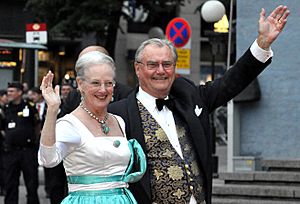
A Monarch is a king or queen. Denmark has the oldest monarchy in Europe. The current monarch is King Frederik X. He became king on January 14, 2024, after his mother, Margrethe, stepped down from the throne.
King Frederik's father, Prince Henrik, was called a prince because he was the husband of the Queen, not the son of a previous King. He passed away on February 13, 2018, at the age of 83. The royal couple had two children:
- King Frederik X married an Australian woman named Mary. They have four children:
- Crown Prince Christian
- Princess Isabella
- Prince Vincent & Princess Josephine (who are twins)
- Prince Joachim married a British woman from Hong Kong but later divorced in 2005 after 10 years of marriage. He has two sons from that marriage:
- Prince Nikolai
- Prince Felix
In 2008, Prince Joachim married for the second time. His new wife is from France and is named Marie. They have a son and a daughter together:
-
- Prince Henrik
- Princess Athena
Images for kids
-
The Ladby ship, the largest ship burial found in Denmark.
-
The larger of the two Jelling stones, set up by Harald Bluetooth.
-
The Assault on Copenhagen on February 11, 1659, during the Second Northern War. Danish defenders successfully pushed back the Swedish forces. Painting by Frederik Christian Lund.
-
Denmark joined the European Union in 1973 and signed the Lisbon Treaty in 2007.
-
Beech trees are common in Denmark's woodlands.
-
Lego bricks are made by The Lego Group, based in Billund.
-
Denmark is a big producer and exporter of pork products.
-
Copenhagen Airport is the largest airport in Scandinavia.
-
Roskilde Cathedral has been the burial place for Danish royalty since the 15th century. It became a World Heritage Site in 1995.
-
The oldest Danish lecture plan, from 1537, at the University of Copenhagen.
-
A statue of the philosopher Søren Kierkegaard.
-
Director Lars von Trier, who helped create the Dogme film movement.
-
A portrait of Hans Christian Andersen (1836), painted by Christian Albrecht Jensen.
-
Michael Laudrup, named the best Danish football player of all time.
-
Margrethe II was the Queen of Denmark from 1972 to 2024.
Related pages
See also
 In Spanish: Dinamarca para niños
In Spanish: Dinamarca para niños





